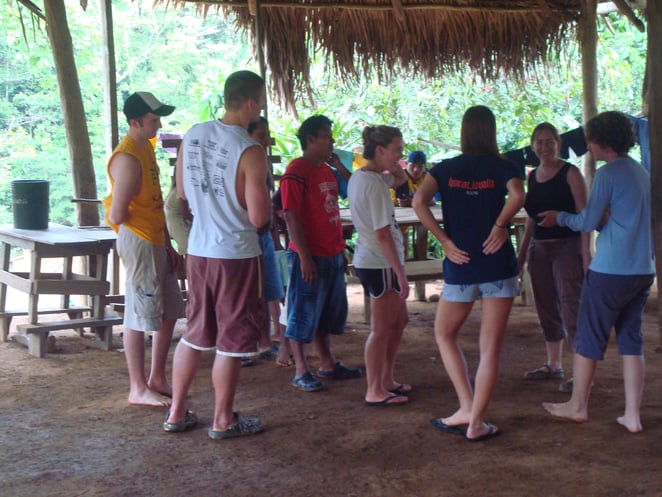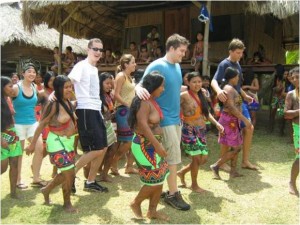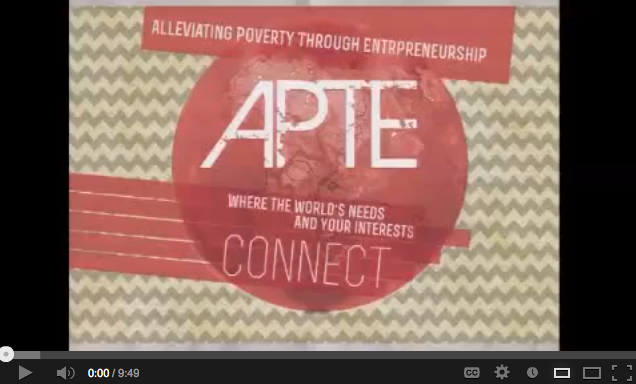We’re continuing our celebration of the Peace Corps’ 50th anniversary by highlighting the ways Global Brigades has partnered with Peace Corps Volunteers. The following is an article written in 2009 by Jeff Diesbrg and Zach Barricklow, two Returned Peace Corps Volunteers, for the PCV Newspaper LA VAINA.
——–
Global Brigades Injects Enthusiasm, Resources and Helping Hands into Volunteer Projects
By Jeff Diesburg and Zach Barricklow
Group 59, CEC, El Valle de Madroño, Panama Oeste
and RPCV Panama (2005-07)
Global Brigades is a young, student-led organization that connects themed student clubs, or “brigades” (i.e. business, law, architecture, environmental, health, etc.) with NGO or governmental agency partners in Central America, to create an exchange of resources, expertise and cultures between local community groups/projects and college students from the U.S.
Working with Global Brigades is an opportunity for you as a PCV to guide and mentor a group of U.S. students in the challenges and opportunities of community development work. It is an opportunity for you to inject some youthful enthusiasm, resources and a helping hand into your projects. Beyond this, it is a chance for you to accomplish the cultural exchange goals two and three of Peace Corps.
The Global Brigades operational model and scope look something like this: They enlist interested university students to start a Global Brigades Club on their campus. Universities like Berkeley, Texas, Florida State, and UCLA have Brigade Clubs. Global Brigades matches the club with a community project in Central America. The club works from the States, in collaboration with Peace Corps Volunteers in the community, to create a project action plan and do research about the assignment given to them by the PCV and community. Then the club selects a group of 15 – 20 students to go on implementation trips. Funds are raised or paid for by the students to cover the in-country logistics. A minimum of one-hundred dollars per volunteer is put in their project’s capital investment fund – which gets donated to the community for specific project needs. Each club is connected to one project and will return to the same community two or three times a year (ideally), bringing a different set of students and more capital to invest. In addition to the cash, the students aid the projects with knowledge from their fields of study or specific information researched between visits. Current projects include a bee keepers group, a shoe cobbler, and a furniture co-op.
The Global Brigades model proves to be remarkably flexible. It started with medical brigades in Honduras and quickly evolved to encompass business, architecture, law and water brigades. The Global Brigades approach to programming and community development is evolving quickly, as the organization continues to grow at a remarkable rate.
Though Global Brigades is a new organization, there is great potential benefit to partnering with them. From either side the arrangement has substantial benefits. A weakness in the Global Brigades formula is the lack of contact between the club and the project members in the long stretches of time between visits. With any service-vacation or developmental-tourism it is critical to avoid becoming just another handout. Peace Corps Volunteers on the other hand, often have trouble finding the minimal funding necessary for projects. Together, Global Brigades and Peace Corps offer funding resources, ideas exchange, cultural exchange and continuity in project support. Also, there is the trust gained by the PCV during two years of service in a community, coupled with the excitement Global Brigades college students fresh from foreign lands inspire like a cloud in their wake.
If you are interested in working with Global Brigades, the first thing to consider is how a group of college students could assist your project. The money is a great incentive, but it is important that you take the lead and guide the club through the planning, implementation and follow-up, so that both the students and the community benefit from the mutual exchange that takes place throughout their involvement (thereby avoiding the “handout effect”). When it comes to the actual visit from students, the greatest service you can do for Global Brigades is to keep them on the right track. Set guidelines to help the students avoid social faux pas. Talk to them about the tricky necessity of responding to community input while recognizing that some things community members ask for are not things they want or could use. Volunteers are ideally positioned to facilitate cultural exchange and limit the “handout” perception of a Global Brigades project.
Photo: Embera Peru Village – ADR Workshop





